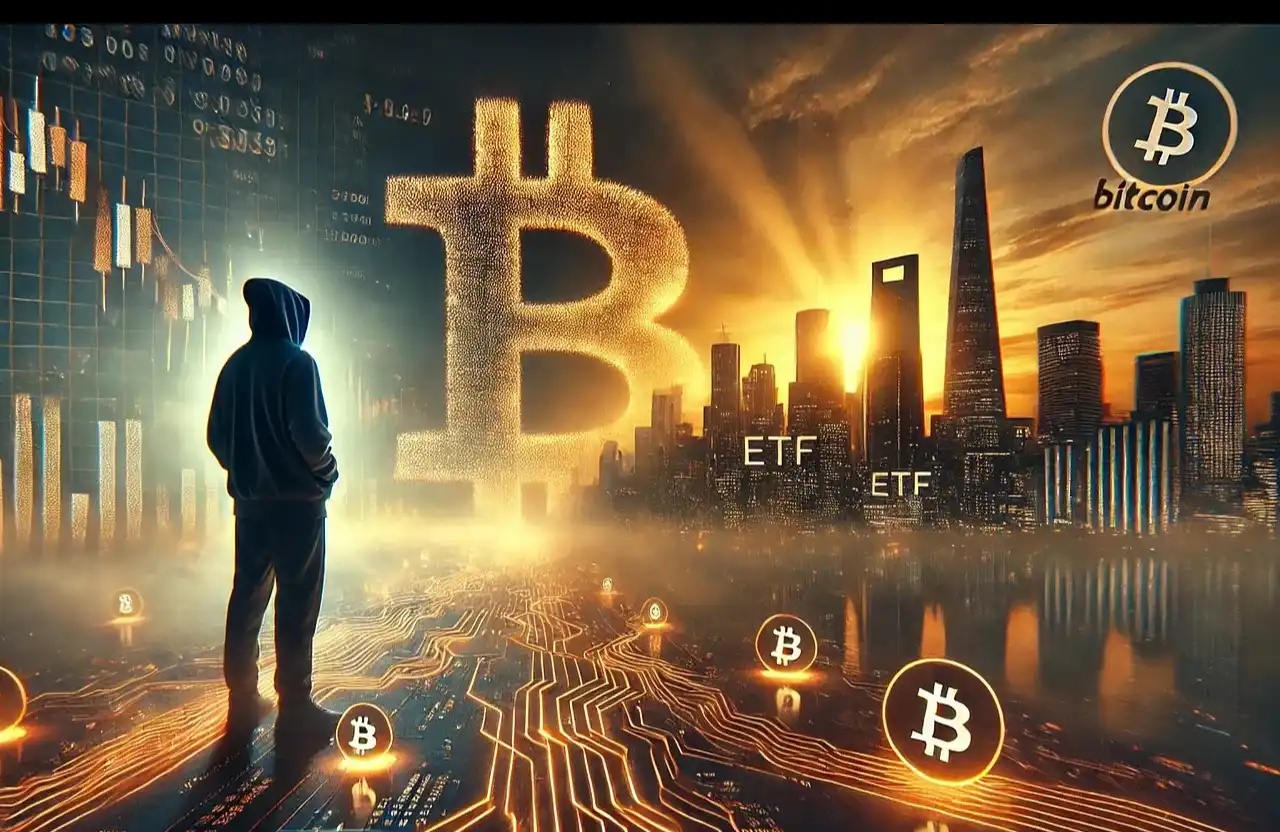Bitcoin Price Crash Incoming? Opportunities in the Dip Stay tuned for the upcoming translation of the content.
Editor's Note: During a period of prolonged consolidation for Bitcoin and a gloomy market sentiment, the author, drawing inspiration from the traditional financial market's IPO post-distribution model, interprets the current Bitcoin phenomena such as its divergence from risk assets, the awakening of ancient on-chain addresses, and OG's (Original Gangsters) large-scale sell-offs as a healthy "passing of the torch." The cypherpunks are now passing the torch to institutional investors and future believers, and the short-term pain may be nurturing long-term strength.
The following is the full text:
Pain is Real
Frankly, the sentiment in the cryptocurrency space right now is very bleak.
The S&P 500 Index is nearing an all-time high. The Nasdaq is surging. Gold just broke $4300. Tech stocks are rebounding. By all traditional measures, we are in a risk-on environment. Funds are flowing into risky assets. Investor demand is strong.
And Bitcoin? Bitcoin… nothing.
Sideways. Grindy. Boring. You can pick any word to describe it, but none can hide the pervading sense of frustration in the community. Twitter is filled with various anxious questions: "Why is everything else pumping but BTC isn’t moving?"
This cognitive dissonance is glaring. We have had successful Bitcoin ETF launches, with monthly inflows. Institutions are coming in fast. The Genius Act has passed, and the Clarity Act is on the way. No regulatory crackdown. No major hacks. No fundamental narrative collapse. All those things that should matter… have happened.
Yet here we are, watching other assets rebound while Bitcoin stands still.
Over the past few years, my connection to the crypto community has grown stronger, giving me a unique perspective. I observe two worlds: the traditional fiat financial system and the crypto ecosystem, and I am starting to see a pattern that reminds me of the world I grew up in. The similarities are striking, and so are the differences. But sometimes, similarities manifest in unexpected ways.
What if everyone got it wrong?
What if Bitcoin isn't "broken" but is finally having its "IPO" moment in the traditional financial world?
Bridging Two Worlds
My crypto journey has been so enlightening precisely because I did not abandon my understanding of the traditional market. I brought that lens in. I increasingly find that while Bitcoin's origins are revolutionary and inherently decentralized, the economic model it follows is as ancient as capitalism itself.
Early investors take on significant risk. If their investment is successful, they deserve a substantial return. However, crucially, they need to realize these gains. They need liquidity. They need an exit. They need diversification.
In the traditional world, this moment is known as an IPO (Initial Public Offering). It's the moment early believers cash out, the moment founders become wealthy, the moment venture capitalists return funds to their limited partners. It's not a moment of failure; it's a moment of success. The company doesn't die during an IPO. It transforms. It matures. Ownership becomes distributed.
Bitcoin has never had a traditional IPO because it has never had a "company." But economic forces don't disappear due to a different structure. They simply manifest differently.
The Departure Revealing the Truth
Let's talk about what we're really seeing in the market right now.
Bitcoin used to move in sync with tech stocks. It was tied to liquidity and "risk appetite." Over the years, you could predict Bitcoin's movements by observing the Nasdaq index. But since December 2024, this correlation has been completely shattered.
This has left people puzzled. It has puzzled algorithmic traders. It has puzzled momentum investors. When risk assets rally and Bitcoin doesn't participate, the narrative becomes "Bitcoin has issues."
But what I've learned from observing the traditional markets is this: This is precisely what happens during an IPO distribution period.
When a company goes public, early investors start selling their positions, and even during a broader market rally, the stock often consolidates. Why? Because a specific dynamic is at play. Early investors aren't panic-selling. They are methodically distributing their positions. They are cautious. They don't want the price to collapse. They are patient. They have been waiting for this moment for years. They can wait a few more months to get it right.
Meanwhile, new investors are stepping in, but very cautiously. They're not chasing highs. They're accumulating on dips. They're waiting to become aggressive after the distribution is complete.
The result? A frustrating sideways market that confounds everyone. The fundamentals are solid. The broader market is rallying. But that one stock... just sits there. Don't believe me, go look at Circle or Coreweave. They had early surges post-IPO pricing, but since then, it's been consolidation.
Sound familiar?
If this is macro-driven weakness, Bitcoin would fall alongside risk assets rather than diverging from them. If this is a true “crypto winter,” we would see panic, capitulation selling, and a sell-off in correlation with the entire space. Instead, what we are seeing is a more specific situation: orderly, patient selling pressure being absorbed by steady buying pressure.
This type of selling feels more like saying “I'm done here, time to move on,” rather than “I'm scared.”
Mounting Evidence
Next, evidence that I did not anticipate but perhaps should have expected emerged.
During a recent Galaxy Digital earnings call, Mike Novogratz announced that Galaxy had sold $9 billion worth of Bitcoin for a client. $9 billion. Think about that number. This is not retail panic. This is not a trader getting liquidated. This is an industry OG (Original Gangster) calmly unwinding a massive position.

But they are taking profits. They are cashing out gains. They are doing exactly what an early investor should do when an asset matures and liquidity is finally sufficient to support a large-scale exit.
And that OG is not alone.
If you know how to read the signs, on-chain data is telling a clear story. Those “ancient” bitcoins, those that have been dormant for years, some since the price was still in the single digits, have suddenly come alive. Not all at once. Not in panic. But steadily, methodically, especially this year and particularly since the summer. Those addresses that accumulated chips back when Bitcoin was just a cypherpunk experiment are finally starting to move their holdings.
Look at the Fear and Greed Index. Look at sentiment on social media. Community morale is low. Retail is surrendering. This is precisely the emotional state you expect when “smart money” is redistributing from “weak hands.”
But most people overlook: if you understand what stage we are in, this sentiment is actually bullish.
Early Holder Psychology
Put yourself in the shoes: If you mined Bitcoin in 2010 or bought in at $100, even $1000.
You've been through Mt. Gox. You've been through (multiple) China bans. You've been through 2018's bear market. You've been through the pandemic. You've been through regulatory uncertainty. You've endured over a decade of mainstream media calling it a scam.
At a time when almost no one believed, you believed. You took the risk. You won. The success of Bitcoin has exceeded almost everyone's wildest expectations.
But now?
You are now sitting on wealth spanning several generations. Your living situation has changed. Maybe you are close to retirement. Maybe your kids are about to go to college. Maybe you are considering diversifying into the AI field, buying a yacht the size of Bezos' one, starting a business, or simply enjoying the fruits of your patient wait.
And for the first time in history, you can truly exit your position without crashing the market.
This is brand new.
For years, liquidity was non-existent. Try selling $100 million worth of Bitcoin in 2015, and you would crash the price. Try selling $1 billion in 2019, same problem. The market couldn't absorb it.
But now? ETFs are providing institutional buy-side demand. Big companies hold Bitcoin on their balance sheets. Sovereign wealth funds are getting in. The market has matured to a point where early holders can exit large positions without causing chaos.
The key insight here: they are choosing to do this in a risk-on environment precisely because that's when buyers have capital. When stocks are up, when confidence is high, when liquidity is plentiful, that's the optimal time to distribute. Selling in fear would crash Bitcoin. But selling when other assets are strong? That's just good business.
This is what the OG whales have been waiting for. Not the price—the price they've had for a while. It's the liquidity. Market depth. The ability to truly exit.
The mission is accomplished. Bitcoin has proven itself. Now it's time to reap the rewards.
Why This Is Not a Bear Market
I can already hear the skeptics: "This just sounds like you're making excuses for a bear market before the end of the four-year cycle."
So let's talk about why this is fundamentally different.
A bear market is driven by fear, macro conditions, and a loss of confidence in the underlying narrative. Remember 2018? Exchanges collapsing. ICOs exposed as scams. The whole space feeling like a fraud. People were selling because they thought Bitcoin might go to zero.
Remember March 2020? A global pandemic. Everything was crashing. People were selling because they needed cash to survive.
The current situation is not what it seems.
Currently, Bitcoin's fundamentals can be said to be the strongest ever. An ETF has been approved — something everyone said would never happen. Institutional adoption is accelerating. The halving occurred as scheduled, like a precise clock every four years. The network is more secure than ever. The hash rate is at an all-time high. The adoption of stablecoins is accelerating, asset tokenization is on the horizon, and transaction volume driven by network effects is about to explode. The dream of cryptocurrency is finally starting to become a reality.

Nevertheless, everyone must remember that cryptocurrency is only three years removed from its darkest days (price collapses, fraud exposure, regulatory crackdowns). Altcoins are still down 20-50% from their highs. In the past two years, Bitcoin has been propping up this space.
Prior to that bubble, venture capital (VC) and hedge funds were the main investors in cryptocurrency, and they have yet to recover. They are still licking their wounds from cryptocurrency and SaaS investments that have been disrupted by the rise of artificial intelligence.
Sellers are selling not because they lost faith but because they won.
This is a crucial distinction.
In a bear market, there are no buyers. Prices crash because everyone wants out, and no one wants in. However, look at what is actually happening now: Bitcoin is consolidating, not crashing. Every dip has buyers stepping in. Prices are not making new lows but holding within a range.
Buyers are stepping in. Just not as aggressively. Just not as emotionally. They are patiently accumulating, waiting for distribution to complete.
This is exactly the pattern you see after a large IPO lock-up period expires. The stock doesn't crash. It consolidates. Early investors sell. New long-term holders accumulate. Ownership transitions from visionaries to institutions.
Lessons from the Traditional Markets
If you want to understand the current phase of Bitcoin, look at what happened to the greatest tech companies after their IPOs.
Amazon went public in 1997 at $18 per share. Within three years, it hit $100. Then over the following two years, despite the internet's continuous growth, it stagnated. Why? Because early investors and employees were finally able to cash out. They were selling. Many who believed in Amazon at $1 were selling at $100. They were right to do so; they got a 100x return. But the stock had to absorb those distributions before it could move higher.
Google's 2004 IPO. The stock traded sideways for nearly two years post-IPO. Facebook? Same pattern in 2012-2013. The end of lock-up periods led to intense volatility and sideways trading.
This is normal. This is healthy. This is what success looks like.
Companies do not fail at this stage. Assets do not disappear. What is happening is a "changing of the guard." Early believers are passing the torch to a new generation of holders who buy in at higher prices and have a different time horizon.
From cypherpunks to institutions. From libertarian idealists to corporate treasuries. From true believers to trustees managing billions in assets.
There is no good or bad. Just evolution. Just the natural lifecycle of a truly successful asset.
Generational Shift
This transition is profound and worth recognizing.
Bitcoin was born out of an ideology. It was created by cypherpunks who believed in decentralization, in breaking free from government control, in the determinism of mathematics over institutional trust. Early adopters were rebels, outsiders, and visionaries who saw what others couldn't.
Those people are now stepping back. They are passing the torch. And the entities taking over, less concerned with ideology, are more focused on returns. BlackRock doesn't care about "being your own bank." They care about portfolio diversification and risk-adjusted returns.
Is this a loss? In some ways, yes. Bitcoin may never again have the same radical energy of its early years. The days of 100x returns in a year may be over. The volatility that created life-changing wealth will likely temper as ownership becomes more distributed.
But it is also a victory. Because Bitcoin has survived long enough to become "boring." It has successfully proved itself to the point where the early believers can truly cash out. It has proved itself to the world to the extent that the most conservative financial institutions are buying it.
More importantly, from a market structure perspective, this distribution is extremely bullish in the long run.
Why Decentralization Beats Centralization
One key lesson I've learned from observing traditional markets, perfectly applicable to Bitcoin: centralization is fragile, decentralization is antifragile.
When Bitcoin was primarily held by a few thousand early adopters, the market was inherently unstable. A few wallets could significantly move the price. One person deciding to sell could trigger a chain reaction in the market. Price fluctuation was driven by the fluctuating holder base.
However, with ownership becoming more decentralized, with millions of investors holding smaller positions rather than thousands holding massive positions, the market has become more stable in structure.
Think about it: If 100 people own 50% of the supply and one of them decides to sell, that's a 0.5% market impact on the entire supply. This would shake the price. But if 1 million people own 50% of the supply and 10,000 of them decide to sell, it's still only 0.5% of the supply, but it's dispersed across thousands of transactions at different times, places, and prices. The impact is diluted.
This is exactly what happens after an IPO. The initial shareholder base is small: founders, early employees, venture capitalists. After the IPO and the lock-up period, ownership becomes fragmented. Millions of shareholders replace hundreds. Index funds. Retail investors. Institutions.
Stocks become less volatile not because the company is less exciting, but because the ownership structure is more robust.
Bitcoin is going through the exact same transformation. The OG whales who could move the market single-handedly are selling to thousands of institutional investors through ETFs, to millions of retail investors through exchanges, to corporate treasuries, to pension funds.
Every Bitcoin moving from concentrated hands to dispersed hands is making the network more resilient. Making the price more stable. Making the asset more mature.
Yes, this means the crazy 10x years may be behind us. But it also means the risk of a catastrophic collapse due to concentrated selling is diminishing.
A diversified holder base is what separates a speculative asset from a store of value. It's what graduates something from a "magical internet money" to a "global monetary asset."
Timeline Ahead
If this argument is correct — and I strongly believe the evidence shows that it is — what should investors expect?
First, patience. IPO distributions typically last 6-18 months. We may have been in this process for several months already, but it may not be over yet. And the Bitcoin time cycle moves faster than fiat assets. I think in Bitcoin time, we have already gone past six months. For now, please continue to expect consolidation. Please continue to expect Bitcoin to be frustratingly non-correlated with risk assets. Please continue to expect subdued market sentiment for a while, but stay alert because (the turnaround) won't have a signal. It will start suddenly because the good news has already been there.

Second, reduced volatility. As ownership becomes more decentralized, the intense volatility seen in previous cycles will ease. The typical 80% retracement seen in the past may turn into a 50% retracement, and a 50% retracement may turn into a 30% retracement. A 10x rebound may become a 3x rebound. This will disappoint fallen gamblers but excite risk managers.
Third, correlation with traditional risk assets may be restored, but only after the distribution phase is complete. Once the OG whales have sold off, once ownership is sufficiently fragmented, Bitcoin is likely to start tracking market sentiment again. Just in a more stable, less volatile manner.
Fourth, and most crucially: sentiment will only improve once distribution is mostly complete. Right now, morale is low because people don't understand what phase we are in. They are waiting for Bitcoin to "catch up" to stocks. They worry about the four-year cycle. Please be patient. Once the heavy selling pressure is relieved, once institutions patiently absorb OG supply, the path forward will become clearer.
The exact timeline is unknowable. But if you've seen this pattern in traditional markets, you'll recognize it.
The Maturation of an Asset Class
Every revolutionary technology goes through this evolution.
The internet had its early believers who built companies with no business model, only a belief in connectivity that would change the world. They were right. Many of them became extremely wealthy. Then came the bursting of the internet bubble and consolidation. Ownership shifted. Dreamers gave way to operators. The internet didn't die; it actually delivered on its promise, just on a longer timeline than the early hype suggested.
Personal computers. Mobile phones. Cloud computing. Artificial intelligence. Every transformative technology follows a similar arc. Early believers take on huge risks. If the tech succeeds, they stand to gain massively. Eventually, they realize those gains. Then comes a period that feels like a failure but is really a maturation.
Bitcoin is following the exact same script.
OG holders took risks in Bitcoin's early days when it could have easily gone to zero. They endured ridicule, regulatory uncertainty, and the pains of technological growth. They built infrastructure, weathered Mt. Gox's collapse, resisted the scaling wars, and preached to deaf ears.
They won. They succeeded. Bitcoin is now a trillion-dollar asset, recognized by the world's largest financial institutions.
And now they are taking away their deserved profits.
This is not the end of Bitcoin. This is not even the beginning of the end. This is the end of the beginning.
From speculation to institutions. From cypherpunk experiment to global asset. From centralization to decentralization. From volatility to stability. From revolutionary to foundational.
The Opportunity in Distribution
Here is something that gives me faith: I have now seen both sides of the coin.
I understand how traditional finance operates. I understand the IPOs, the end of lock-up periods, and the pattern of institutional accumulation. I also understand the crypto community, the hopes, the setbacks, and the belief that "this time is different."
Sometimes it truly is different. Sometimes it isn't.
What is happening to Bitcoin now is not fundamentally different. It is simply the same economic forces that have ruled markets for centuries playing out in a novel context.
The sense of frustration everyone is feeling? This is not a sign of failure. It is a sign that we are going through the most difficult part of the journey—the early believers cashing out, and the later believers feeling they missed out. It's uncomfortable. It's disheartening. But it's necessary.
And here is the key insight that should give long-term investors confidence: once this distribution phase is complete, Bitcoin will be structurally stronger than ever before.
When ownership is dispersed among millions of investors rather than concentrated in the hands of a few early whales, the asset becomes more resilient. Less susceptible to manipulation by a single entity. More stable. More mature. More capable of absorbing true capital without causing wild swings.
The IPO is nearing completion. The OG whales are reaping their rewards. And what emerges on the other end is a Bitcoin prepared for the next stage: no longer as a speculative tool for outsized returns, but as a foundational currency asset with a distributed, stable holder base.
For those who bought in at $100 dreaming of $10 million, this may sound mundane. But for institutions managing trillions, companies seeking treasury diversification, and nations exploring reserve assets, "mundane" is exactly what they want.
The concentrated excitement is being replaced by the persistent decentralization. Early believers are passing the torch to long-term holders who bought in at higher prices with different motivations.
This is what success looks like. This is Bitcoin going through its IPO.
Once it is completed, once the distribution process is finished, once ownership is sufficiently fragmented, true institutional adoption can truly begin. Because the market will ultimately be able to absorb real capital without having to worry about a large concentration waiting to exit causing potential selling pressure.
The consolidation is frustrating. The sentiment is very negative. The divergence from risk assets is confusing.
But the fundamentals are stronger than ever. And this structure — the distribution of ownership from centralization to decentralization — is exactly what Bitcoin needs to transition from a revolutionary experiment to a enduring monetary asset.
The OG whales are going through their liquidity events. Let them. This is what they deserve. What they are leaving behind is a Bitcoin that is stronger, more decentralized, and more resilient than when they accumulated.
This is not a reason for despair. This is a reason to buy.
Bitcoin's volatility is the price it paid at birth. Its stability will be the proof of its maturity.
Welcome to join the official BlockBeats community:
Telegram Subscription Group: https://t.me/theblockbeats
Telegram Discussion Group: https://t.me/BlockBeats_App
Official Twitter Account: https://twitter.com/BlockBeatsAsia


 Forum
Forum Finance
Finance
 Specials
Specials
 On-chain Eco
On-chain Eco
 Entry
Entry
 Podcasts
Podcasts
 Activities
Activities
 OPRR
OPRR







